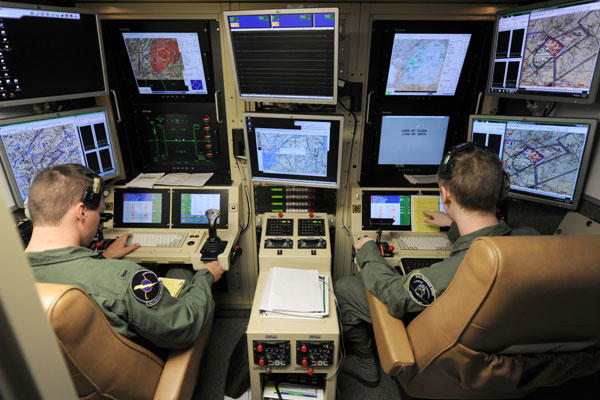The U.S. Air Force needs to do more for its overworked drone pilots, a specialized force that has little time to train and suffers from low morale, according to a recent report by a government watchdog.
The Pentagon has dramatically expanded its use of drone aircraft in the last decade to support the wars in Iraq and Afghanistan. The Air Force has a requirement to perform 65 combat air patrols a year using the MQ-1 Predator, MQ-9 Reaper and the larger RQ-4 Global Hawk unmanned aircraft. That's more than three times the number of these patrols drone pilots conducted in 2007.
In 2010, the Pentagon directed the Air Force to increase personnel working in drone squadrons to reach 65 CAPs by fiscal year 2013. The service concluded that it needs about 10 remotely piloted aircraft operators to conduct one 24-hour drone mission.
Using this crew-ratio, the Air Force determined it needed up to 1,650 drone pilots and support personnel to sustain the 65-CAP requirement, according to a Government Accountability Office report.
"In 2008, the Air Force determined the optimum number of RPA pilots--the crew ratio … but it did not account for all tasks these units complete. Air Force officials stated that, as a result, the crew ratio is too low, but the Air Force has not updated it," the GAO report states. "Air Force guidance states that low crew ratios diminish combat capability and cause flight safety to suffer."
The high operational tempo of the job limits the time available for training and professional development.
"The Air Force Unmanned Aircraft Systems Flight Plan 2009-2047 states that it is imperative to provide the necessary training and opportunities for advancement that will create a cadre of future Air Force leaders. However, unit commanders in each of the three locations we visited and some RPA pilots stated that the high pace of operations and demand for RPA capabilities limited their units' time to train for the various mission sets that RPA units are required to perform," according to the GAO report.
"One RPA unit had to spend about 95 percent of its work hours in fiscal year 2013 flying combat-operations missions and the remaining 5 percent flying training missions, logging around 19,600 hours flying combat missions, compared to about 940 hours of training missions."
Air Force studies have also found that working long hours was one of the top five reasons for stress among personnel in RPA squadrons. In the studies, over 57 percent of respondents reported that they worked more than 50 hours per week. In addition, the studies found that over 40 percent of respondents reported that performing administrative duties added hours to their work week and was the third-highest reason for stress among active-duty RPA personnel, the GAO states.
The Air Force has taken some actions to address potentially difficult working conditions drone pilots face, but "it has not fully analyzed the challenge pilots face to balance their warfighting roles with their personal lives," GAO states.
"RPA pilots operate RPAs from bases in the United States and live at home; thus they experience combat alongside their personal lives--known as being deployed-on-station--which RPA pilots stated negatively affects their morale," according to the report.
The Air Force monitors RPA pilot promotion rates, but has not analyzed factors that may relate to their low promotion rates. The service analyzed promotions across a group of officers, including RPA pilots, and found factors that related to promotions in general. However, the Air Force has not analyzed the factors related to RPA pilots' promotions specifically and does not have the information to determine what factors may affect their promotions, the GAO found.
GAO recommends that the Air Force:
- Update optimum crew ratios and establish a minimum crew ratio
- Develop a recruiting and retention strategy
- Evaluate using alternative personnel populations to be pilots
- Use feedback from RPA pilots
- Analyze the effects of being deployed-on-station
- Analyze the effect that being an RPA pilot has on promotions
The Air Force concurred with most of the recommendations and is working to implement them, the GAO said.
The service has recognized that new officers recruited into the RPA pilot career field need a group of more-senior officers to serve as mentors and leaders.
So in 2011, the Air Force permanently recategorized around 475 manned-aircraft pilots who were generally serving at the ranks of major and lieutenant colonel to serve as permanent RPA pilots, according to Air Force documentation.
Air Force officials stated that these more-senior pilots would help provide a leadership and experience base for the new RPA pilot career field. In addition, another 70 manned-aircraft pilots have been permanently recategorized as RPA pilots since 2011, GAO said.
-- Matthew Cox can be reached at Matthew.Cox@monster.com.































